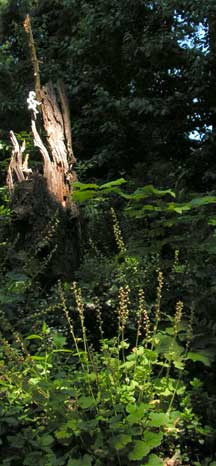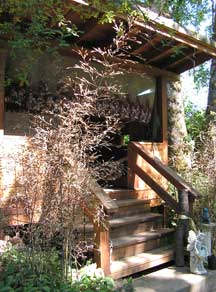 |
Previous Issues |
| Cedar Mill Community Website |
|
| About Cedar Mill News |
|
||||||
| Volume 5, Issue 6 | June 2007 |
|||||
|
 |
Native fringecup is a relative of coral bells |
The riparian area is part of the headwaters of Willow Creek. It was originally a “sheet flow” across the lower part of the property, probably originating from one or more of the numerous springs in the area. When a sewer line was installed through it for the subdivisions next door, the contractors created a channel that made a creek bed. Two culverts drain the runoff from the subdivision streets. “When the first big rains come in the fall, we see mounds of foam in the stream from car-washing soapsuds that have built up on the roads,” Bruce says. “It’s a graphic illustration of why not to wash your car in your driveway.“
“Before we ever built the house, we spent a lot of time wandering the property, discovering and creating trails and getting a feel for the land,” Joan explained. “We saw a couple of seasons go by, and by the time we were ready to start the garden, we had a good idea of what we wanted. Our vision was a woodlands garden. We took what the landscape already had to offer and worked with that.” Many of the plants in the garden are not only native, but indigenous to the property. Others have been salvaged from nearby property that was slated for bulldozing. They also shop at plant sales held by the Hardy Plant Society, Berry Botanic Garden and other groups.
Bartlett, like most naturescapers, isn’t fanatic about only using natives. Many of the plants are “exotic” relatives of native plants that are hardy (can survive our winters) and non-invasive. Native fringecups, in the Saxifrage family, are joined by their showier relatives coral bells. Hybrid monkeyflowers and tiger lilies put on a more varied show than their smaller native cousins.
When they began their garden, there wasn’t much of a “naturescaping” movement. They learned natural gardening techniques simply by finding out what worked best to achieve the results they wanted. “Getting the soil in shape is most important,” says Bruce. “This soil bakes hard without amendments, and it seems to be doing it earlier every year.” The soil in our area, especially in the foothills, is mainly comprised of a thin layer of wind-blown silt from the valley, covering a crumbly basalt that allows ground water to seep up in springs. “We cultivated beds in the beginning, adding mulch and wood chips, but my goal is to get to the point of just adding organic material to the top layer and not doing any more regular cultivation,” Bruce says.
 |
| Inspiration for the lanai came from a trip to Hawai'i and was built mostly from wood milled onsite |
To combat weeds, timing is everything. Bruce notes, “I get out and weed, fertilize and mulch around the winter solstice, before the bulbs start growing. Then in the summer I mow the camas area before the bedstraw (cleavers) and other noxious weeds go to seed. Getting things before they go to seed is critical to keeping weeds under control. But also,” he smiles, “a higher tolerance for weeds is helpful.” A lot of natives could be called weeds by some gardeners. Part of the aesthetic of naturescaping is learning to appreciate the beauty of natives in their natural setting.
Using less water is one of the major financial benefits of naturescaping, and the grass in the meadow will likely be brown by the time of the tour. “People will see the evergreen ‘bones’ of the garden, and they’ll experience the wooded glen features. The vegetable garden should be in full swing by then also,” he says.
Rock Creek Watershed Partners (rcwp.org) will be helping the Bartletts host the tour, and will be providing a map of the property highlighting the various microclimates and planting solutions, along with a list of plants used in the garden. They’ll also be available with advice for those interested in following some of these techniques in their own gardens.
Cedar Mill Business Association
Published monthly by Cedar Mill Advertising & Design
Publisher/Editor:Virginia Bruce
503-629-5799
12110 NW West Rd
Portland, OR 97229